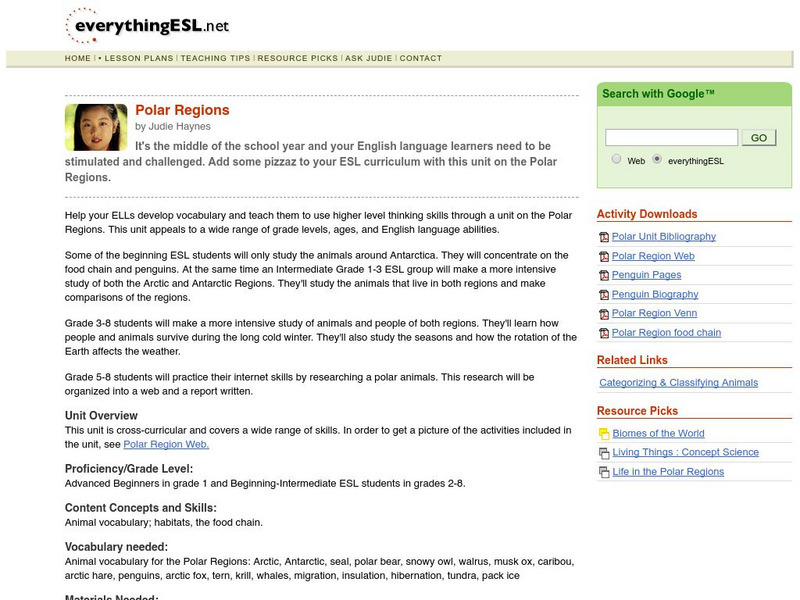Curated OER
Head to Foot
Students describe the body form and major anatomical structures of squids and describe some unusual or unique features of newly-discovered deep water squid species. They infer what types of food squids use from their anatomical features.
Curated OER
Noah's Ark, Revisited
Fourth graders do a visual presentation for a specific endangered species.
Curated OER
Language Arts: Five Senses Walk
First graders take a discovery walk around the school. They use their observations to compose a class book about their school.
Curated OER
Leaving Home
Learners explain the importance of larval dispersal and retention to populations. They collect data on organisms and examine it.
Curated OER
Florida's Springs
Young scholars follow the journey that water takes in aquifers and springs. They write about the major threats to the aquifer and the solutions to these threats.
Curated OER
Biodiversity: El Imposible National Park, El Salvador
Fifth graders explore the concept of how the more diverse an ecosystem is, the more interdependence of species exists within that system. The complex relationships among diverse species are difficult to identify. As species disappear or...
Curated OER
Workers on Sea and on Land
Students use photos of sailors and workers in the shipbuilding industry as a reference point to generate questions and investigate the working conditions for resource industry workers in 19th and 20th centruy Atlantic Canada and the...
Curated OER
Mallard's Wet Olympics
Students investigate some of the different characteristics of living things. They make observations from reading and interactive media. Students observe that animals move in different ways and have adaptations to aid in that action.
Curated OER
What Do You Do With A Butterfly Garden?
Fifth graders build a butterfly garden and perform caretaker duties. They volunteer to perform authentic tasks related to their personal interests. Students research butterfly gardens to determine what plants are necessary for the...
Curated OER
A World of Feathered Friends
pupils will learn to
respect the nature around them. This respect is vital because ignorance of surrounding
nature can lead to carelessness when curiosity goes awry. A perfect example of this
wayward curiosity took place at our school...
Curated OER
Communication in Bees
Eighth graders identify and interpret a scientific investigation and a hypothesis through experimentation and testing a hypothesis. They identify what scientists hypothesized about the communication of stingless bees. Finally, 8th...
Curated OER
Water Quality Monitoring
Students comprehend the four parameters of water quality. They perform tests for salinity, dissolved oxygen, pH and clarity or turbidity. Students comprehend why scientists and environmental managers monitor water uality and aquatic...
Curated OER
Global Change — Change and Cycles Where Land, Air and Water Meet
Students participate in an experiment to define a parts-per-billion solution. For this ecology lesson, students select a second substance to create a parts-per-billion solution and observe and record their results. Students work in...
BBC
Bbc Schools: Ks2 Bitesize: Science: Living Things: Plant and Animal Habitats
Place the aliens in the habitats where they can survive the best. Following the activity, read more about plant and animal habitats, and then take a quick quiz to check for understanding.
Everything ESL
Animal Habitats: The Polar Regions
Stimulate and challenge your ESL students with a unit on Polar regions. Students will use higher level thinking skills while learning about animals, habitats and food chains. You will find many downloadable pages.
CPALMS
Cpalms: Home Is Where the Heart Is: Researching Habitats
[Free Registration/Login Required] In this lesson plan, students will learn about different types of habitats as they gather information based on provided research questions. Students will summarize the information from their research in...
A-Z Animals
A Z Animals: Reference: Habitats
This entry identifies defining characteristics of animal habitats, including chemical cycles, biodiversity and distribution.
PBS
Pbs Kids: Plum Landing: Map Animal Habitats
In this Plum Landing activity, students will write or draw descriptions of where animals live in their neighborhoods. Students can publish their descriptions online.
ReadWriteThink
Read Write Think: Webcams in the Classroom: Animal Inquiry and Observation
Observe animal behavior patterns and their habitats using one of the many webcams broadcasting from zoos and aquariums around the United States and the world in this inquiry-based activity that focuses on observation logs, class...
Utah Education Network
Uen: Animal Adaptations
A multitude of activities provide help with understanding animal adaptations.
Discovery Education
Discovery Education: Habitats of the World
This site has a lesson to use to start a unit on biomes and animal habitats. This plan incorporates grasslands, temperate forests, tropical rainforests, deserts, polar ice regions, and tidepools.
Alabama Learning Exchange
Alex: Habitats
What is a habitat? In this lesson, students will identify that a habitat has four elements, food, water, shelter, and space. Students will identify their own habitat and create a brochure describing the habitat in terms of food, water,...
Houghton Mifflin Harcourt
Harcourt: School Publishers: Animal Communities
At this site click on the pictures to find out about an animal community in Africa. Think about how animal communities are like your community. Think about how are they different.
Nature Conservancy
The Nature Conservancy: Gardens Activity Guide: Habitats
In this lesson learners learn how the garden provides habitat for a variety of different animal species. They make observations and collect data to determine which species inhabit the garden. They will investigate relationships among...
Other popular searches
- Powerpoint Animal Habitats
- Animal Habitats in Georgia
- Animal Habitats Math Games
- Animal Habitats Kindergarten
- Plant and Animal Habitats
- Lessons on Animal Habitats
- Animal Habitats Adaptation
- Math Animal Habitats
- Animal Habitats and Zoos
- Animal Habitats Bear
- Animal Habitats Webquest
- Australian Animal Habitats

























